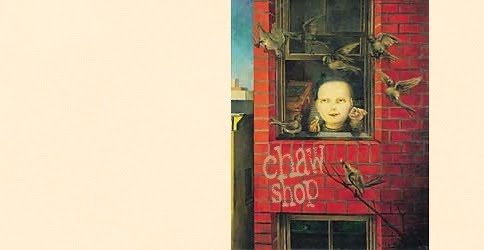As readers of this blog have no doubt gathered, I am a sucker for many things, but my first love is probably postmodernism. By that, I'm referring especially to artists and writers who appropriate images from history and pop culture, transforming them into raw material for something new. Whether it's a Patton Oswalt stand-up routine (wherein he declares that during the apocalypse, Avril Lavigne will appear in the sky to recite the Good Will Hunting screenplay while sentient razors slice at our flesh) or a Thomas Pynchon novel (where Malcolm X and Mickey Rooney make cameo appearances), there's something about this technique that, in the right hands, works like catnip on me.
And yet, paradoxically enough, a lot of art I've hated employs these same techniques. Watching the second Shrek movie was akin to having a strand of piano wire threaded in one of my ears and out the other, and Moulin Rouge gave me the queasy feeling associated with eating a meal entirely made from refined sugar. Cultural icons -- Porky Pig, Elvis, the Disney castle -- can come trailing associations and emotions: nostalgia, comfort, desire. But they can also carry with them an aura of corporate impersonality and cynicism, functioning as placeholders for content the work's creator was too lazy or unimaginative to provide. Characters are not beautiful, but "beautiful," not evil, but "evil," and we know at once what response they're meant to elicit, despite the fact we feel little to nothing at all. Far from sending up consumer culture, postmodern works of this kind can seem like just another product of it, manufactured on a storyteller's assembly line, where interchangable parts are twisted together efficently, each functioning the same way in a different machine.
Here's where Henry Darger comes back in. Entirely on his own, with no formal artistic training or in fact, much education of any kind, Henry Darger invented postmodern techniques. He traced, copied, and photographically enlarged images from magazines and coloring books; he pasted in images snipped from illustrations. Yet, unlike the makers of, say, The Family Guy, he did this entirely without irony; his paintings neither wink nor nudge. His desire was completely sincere: to create in reality the world in his head. His postmodernism, like a modern cave painting, employs any and every available tool, without disdain for any of them, and without a concern for genre or "school."
In fact, I think it's fair to say he didn't like school. (See college professor hat, bottom left.)
In a way, Darger's naivete legitimizes postmodernism for me, because it reveals that the logic of appropriation isn't merely something learned -- an artistic shorthand, a trick. Rather, in the context of our modern society, it's something primal, even primitive: a dialect we grow up speaking, almost despite ourselves.



2 comments:
What's the good kind of irony in a work that consistently appropriates and contrasts old forms and references -- the "not postmodern" kind, maybe? Are we talking about postmodernism as a means and not as an end (or a project)?
I guess that for me, the "good kind" of irony is irony that *intentionally* transforms the meaning of the images it employs -- the same kind of transformation that's happening *unintentionally* in Darger's work. The "bad kind" of irony, on the other hand, is when the images' meaning remains untransformed -- when they function as a cursory reminder of something we all know, rather than to reveal something new.
An example of "good" irony: Barthelme's use of Biblical language in The Dead Father. An example of "bad" irony: the borrowed movie-of-the-week sentimentality at the end of almost any Adam Sandler picture besides Punch-Drunk Love.
Post a Comment